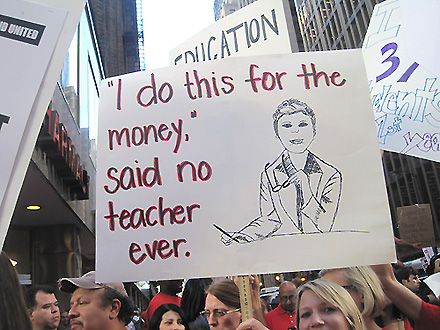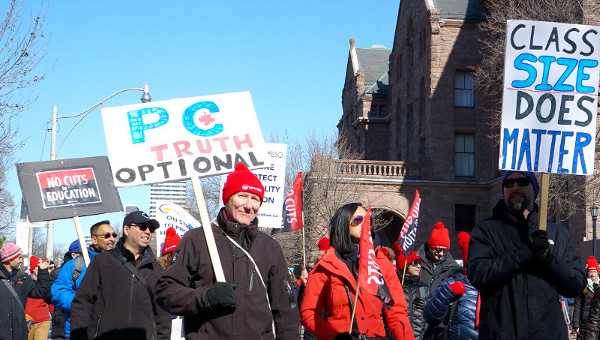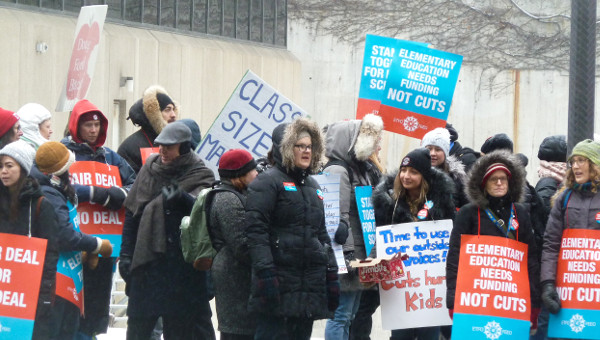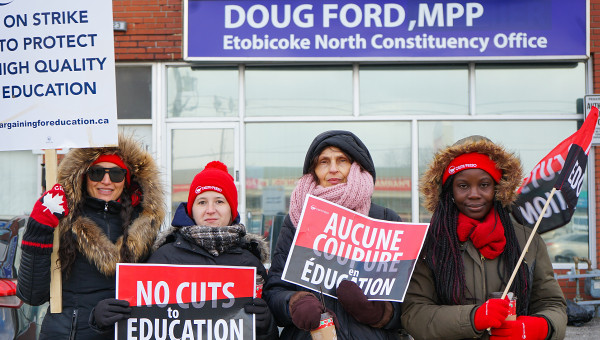New Unions, New Alliances, New Politics
The U.S. working-class was slow to respond to the hard times it faced during and after the Great Recession of 2007-2009. Finally, however, in February, 2011, workers in Wisconsin began the famous uprising that electrified the country, revolting in large numbers against Governor Scott Walker’s efforts to destroy the state’s public employee labour unions.

These three rebellions shared the growing awareness that economic and political power in the United States are firmly in the hands of a tiny minority of fantastically wealthy individuals whose avarice knows no bounds. These titans of finance want to eviscerate working men and women, making them as insecure as possible and wholly dependent on the dog-eat-dog logic of the marketplace, while at the same time converting any and all aspects of life into opportunities for capital accumulation.
Capital, On the Offensive
The public sector is still, despite the effort of capital to dismantle it, the one sanctuary people have against the depredations of the 1 per cent. Through struggle, working men and women have succeeded in winning a modicum of health care and retirement security, as well as some guarantee that their children will be educated, all irrespective of the ability to pay for these essential services. They have also found decent employment opportunities in government, especially women and minorities. The public sector, then, is a partial barrier to the expansion of capital in that it both denies large sums of money to capitalists (social security funds, for example) and protects the workers in it from the vagaries of the labour market. It is thus not surprising that capital has gone on the offensive against government provision of whatever is beneficial to the working-class. In this, it has been remarkably successful. Financiers have used their think tanks, foundations, and political donations to pressure governments at all levels to slash and to privatize public services. They have found willing handmaidens in government, from mayors and governors to President Obama. The depth of this has been described by economist Michael Hudson in CounterPunch:
“… financial elites are demanding privatization sell-offs from debt-strapped governments. Pressure is being brought to bear on Detroit to sell off its most valuable paintings and statues from its art museums. The idea is to sell their artworks for tycoons to buy as trophies, with the money being used to pay bondholders. … [A] new neo-feudal rentier class [is] eager to buy roads to turn into toll roads, to buy parking-meter rights (as in Chicago’s notorious deal), to buy prisons, schools and other basic infrastructure. The aim is to build financial charges and tollbooth rents into the prices charged for access to these essential, hitherto public services.”
Not only will working people become increasingly insecure, but to secure essential services, they will have to pay the new owners monopoly prices.
The flashpoint of the war being waged by capital and its political allies against the public provision of services is education, especially that which serves poor and minority communities. Billionaires like Bill Gates (Microsoft) and the Walton family (Walmart) have established organizations and contributed enormous sums of money to do two things. First, they seek to revolutionize the way in which students are taught. Here they have achieved great victories, with two presidents enacting sweeping laws: No Child Left Behind and Race to the Top. Both condition federal aid to schools upon what has been described as “teaching to the test.” Literature, art, music, and all critical education are to be sacrificed so that children do well on standardized examinations. Then, how schools and their teachers fare, including whether or not a school continues to exist, depends on students’ scores.
Second, these plutocrat “reformers” want to alter radically the way in which schools are organized. The best way to describe their aim is to say that they want the schools to resemble assembly lines, with students as outputs and teachers as assembly-line-like mechanisms who do not think or instill in their students the capacity to conceptualize critically and become active participants in a democratic society. And this Taylorization of schooling has a military-like component, with pupils expected to react to commands with rote discipline and respond unthinkingly to rewards for appropriate behavior.
For a good example of what is in store for our children, see the astonishing article “The Silent Treatment: A Day in the Life of a Student in ‘No Excuses’ Land,” in the excellent edushyster blog, about a proposed charter school in the impoverished working-class town of Fall River, Massachusetts. The movements and speech of the students in this school will be controlled from the time they enter the school bus until they return home. They will speak only when addressed by their teacher, and their responses will be tightly choreorgraphed. Needless to say, the achievement of these horrible goals is most likely to occur if the schools are privatized and the unions destroyed.
If those who are prosecuting this onslaught against our public schools succeed, they will have made workers more insecure, created a compliant, alienated, and low-wage labour force, and devised new ways to make money – a massive testing industry, for-profit schools, consulting services. They will also have put another nail in the coffin of democracy. We should note that capital has already accomplished a good deal. Testing is now the norm; charter schools abound; and the mass media have joined the crusade against public school teachers. A reporter for the New York Times, for example, found it “curious” that in states where teachers, themselves, must be evaluated for competence; almost all teachers passed the test. She did not seem aware of her bias, that she simply accepted as fact that many teachers were incompetent, just as the “reformers” have been telling us. To prevent this from happening, states such as New York are implementing teacher testing that makes the evaluation of teachers more dependent on how their students perform on standardized tests. In New York City, where unionized public school teachers have been working without a collective bargaining for four years, the state’s education commissioner has imposed an evaluation system. The United Federation of Teachers (UFT) claims that the teachers have protection against arbitrary use of the results. However,
“… UFT members now face the possibility that they could lose their jobs if they receive ‘ineffective’ ratings two years in a row. Teachers will be ranked ‘highly effective,’ ‘effective,’ ‘developing,’ or ‘ineffective’ – or, as John Surico at the Village Voice describes it, ‘Instead of pass/fail, we now have more of a letter-grade-esque method to grade our educators with more lethal consequences if you earn too many Fs’.
“The deal requires that 20 to 25 per cent of the teacher’s rating come from state tests, another 15 to 20 per cent from ‘measures established by the school,’ and 55 to 60 per cent from in-class observations or video-recorded performance assessments by principals.
“But an ‘ineffective’ rating on the tests trumps the other measures. … ‘Teachers rated ineffective on the tests have to be rated ineffective overall. Even a glowing teacher with great rapport with her students, if the test scores don’t rise at the predetermined level, that teacher has to be rated ineffective.’”
Teachers, On the Counteroffensive
Teachers have begun to mount a counteroffensive against the debasement of their work and the test torment of their students. At the forefront of this fightback has been the Chicago Teachers Union (CTU). Chicago’s financial and political leaders have been trying to destroy the city’s public schools and the teachers’ union since 1995, “when the Illinois State Legislature gave then-Mayor Daley the power to appoint the Board of Education and choose a CEO to run the schools. The appointed board and a succession of CEOs pushed an unprecedented level of high-stakes testing, accountability, and top-down corporate management. Mayoral control was the lynchpin of this process.” Eric Gutstein and Pauline Lipman tell us that this process has escalated dramatically over the past decade:
“By 2012, Chicago Public Schools (CPS) had closed over one hundred schools (overwhelmingly serving low-income black and Latina/o students), about one-sixth of Chicago’s schools. CPS simultaneously opened almost one hundred privately run charter schools and created thirty-five ‘turn-around’ schools. These moves undermined local school democracy (e.g., the new schools have no Local School Councils – formal bodies for direct, substantive parent and community involvement in local school governance) and teachers’ union membership (charter school teachers cannot join the CTU). In 2012, Mayor Emanuel proposed closing up to 120 more schools by fall 2013, more than all the schools closed in the past ten years.”
In a challenge to the weak response of the CTU to this, the Caucus of Rank and File Educators (CORE) was formed in 2008 and began to revitalize the union, with a focus on an educated and involved rank-and-file and the forging of strong bonds with poor communities to resist school closings and austerity measures. Its electoral slate won leadership of the CTU in 2010, and when Mayor Emanuel pressed forward with his neoliberal agenda and refused to make any concession to union negotiators, the union struck, the first school strike in Chicago in twenty-five years. Much to the surprise of Emanuel and his corporate and political backers – including President Obama and U.S. Secretary of Education Arne Duncan – the strike was supported by most parents, students, and the larger Chicago public. After nine days, the city gave in and signed an agreement that avoided the worst aspects of the Mayor’s proposals. It was a stunning victory for CORE and for teachers, not just in Chicago but across the country.
A few months after the strike, CORE’s leadership was reelected, proof that what it did before and during the strike won the allegiance of most of the city’s teachers. It will now be able to deepen its power and continue to mobilize parents, students, and communities to continue to struggle against the neoliberal education agenda and to begin to develop a democratic and radical alternative. In addition, the CORE model has begun to spread to other cities and states. In January of 2013, teachers, parents, and students in Seattle began a boycott of standardized testing in reading and mathematics and won a ruling by the school board that such testing would now be optional. Union reformers have begun CORE-inspired organizations in Los Angeles and New York City, and a reform slate just took leadership of the local union in Washington, D.C., where the school district was once run by the notorious union-buster Michelle Rhee. A similar group nearly won power in the Newark teachers’ union. In Philadelphia, people are engaged in a hunger strike to protest what will happen this coming Fall if proposed cuts are put into effect: “Ten thousand unused musical instruments. No sports or art programs. No assistant principals, counselors, cafeteria aides or secretaries.”
“However, while hope springs eternal, we should understand that powerful obstacles face all labour reform efforts, including that spawned by the Chicago Teachers Union.”
Most of us who see the need for a radical labour movement in the United States, or at least one that embraces the old Industrial Workers of the World motto that “an injury to one is an injury to all,” tend to see every victorious strike or Wisconsin-like uprising as the start of something new and revolutionary. However, while hope springs eternal, we should understand that powerful obstacles face all labour reform efforts, including that spawned by the Chicago Teachers Union.
First, while the CORE and the CTU won a remarkable victory with the strike, the union still faces powerful enemies: billionaires who control large swathes of the economy, the nation’s political machinery, and the media. They have the capacity to engage in smear campaigns, spy on anyone they choose, hire provocateurs, and otherwise destroy those who defy their wishes. When they suffer a defeat, they don’t crawl into a corner and lick their wounds; they find new ways to get what they want. The CTU did not manage to win the things they wanted most. As one long-time high school teacher and union activist pointed out:
“[The CTU] was unable to: significantly slow the mayor’s crusade to close scores of schools; halt district funding for mostly non-union, privately run charter schools; stop the lengthening of the school day and year without adequate employee compensation; or prevent the establishment of a teacher evaluation system based to an important degree on unreliable student scores on standardized tests.”
What is more, Emanuel didn’t miss a beat in continuing to close schools. His handpicked school board agreed to close another forty-nine schools, the largest mass closing in U.S. history. Draconian budget cuts have been implemented, targeting mainly poor communities while maintaining funding for schools in richer areas and continuing the move toward charter schools. Labour journalist David Bacon tells us that “at Kennedy High School, for instance, a reduction from $15 to $13-million will cause the elimination of four of its five counselors, the school librarian, a clerk and special education personnel. Blair Elementary, which focuses on special education, is getting a 75% budget cut, and will lose seven special ed teachers, one general education instructor, and up to eight paraprofessionals.”
School principals are to gain broad new powers to hire and fire teachers and to decide how funds are to be spent, under a new budgeting scheme that lumps teachers’ pay in with every other expenditure. Each school will be allocated funds according to the number of students. Instead of the number of teachers being determined by rules for class size, staffing will be determined by principals, who will now have a fixed sum of money available to them. Therefore, administrators will have a strong incentive to get rid of tenured, better-paid educators in order to stretch tight budgets as far as possible.
The CTU has vigorously opposed the new cuts, with mass protests by teachers, parents, and students, in which scores of protestors have been arrested. These actions saved a few schools from closure. The union is planning more protests, lawsuits against the closings, and efforts to rid the city of Mayor Emanuel and hostile state legislators. A massive voter registration campaign is in the works. These are praiseworthy efforts, but they are defensive and certainly not assured of success.
Second, while the joining together of teachers and communities is essential to the consolidation of both union and citizen power, more solidarity will be needed if a labour movement worthy of the name is to be built. The working-class itself will have to be mobilized, beginning with members of the teachers’ unions nationwide and spreading to those of other unions, in Chicago and everywhere teachers are on the march. Here prospects are not very promising. The American Federation of Teachers (AFT) and the National Education Association (NEA) long ago abandoned the militancy that marked their beginnings and embraced the business union model, focusing strictly on wages and benefits, forming partnerships with management, and ignoring issues of social justice. As what is happening in the public schools now shows, this was a recipe for disaster, one that continues. As labour journalist Lee Sustar points out, conservative leaders still rule the teachers’ unions: “AFT President Randi Weingarten has been directly involved in negotiations in New Haven, Baltimore, Pittsburgh and Cleveland, in which teachers abandoned their longstanding opposition to merit pay and accepted the weakening of teacher job security.”
This past April Weingarten embraced the Common Core State Standards for mathematics and language arts, which were developed by school administrators, college professors, and representatives of private education companies. These standards were, in effect, imposed by the federal government on the states with the threat of denial of funds under Race to the Top. They were not tested, sanctify dubious “skills,” and do not have the benefit of input from either public school teachers or parents. Where they have been implemented, standardized test scores, tied to the standards, have plummeted, delighting those who have been attacking the public schools, who hope that the poor test results will drive communities to abandon them in favour of charter and private schools. Weingarten did urge a moratorium on using test results to punish schools and teachers, until the standards can be made to work effectively. She thus sounds a progressive note while accepting the premises she should be rejecting out of hand.
If the teachers’ unions are unlikely to aggressively support the CTU and other radical local union actions, the rest of organized labour is still less likely to do so. Support might come from local unions, but, except for the United Electrical Workers and perhaps a few others, national unions will be missing in action. These are still mired in the muck of labour-management cooperation; they are top-down autocracies, afraid of their own members. Like the AFL-CIO, the federation to which most of them belong, they are joined at the hip to the Democratic Party, whose leaders and major money donors support Rahm Emanuel and not public school teachers.
Third, rank-and-file insurgencies, in and of themselves, do not guarantee that a union will be radically transformed. The new leaders are susceptible to cooptation by employers and political elites, and to a retreat to business as usual when times get tough. Creating a new, more democratic culture within a union is hard work; it requires patience, rank-and-file education programs, a willingness to trust the members, and a commitment to a permanently adversarial relationship with those sitting across the bargaining table.
Finally, the fact that a group of reformers gets elected to lead a union does not mean that the union will embrace the kind of class conscious, anti-capitalist perspective that alone could help create a labour movement. COPE’s commitment to embed itself in the communities that teachers serve, especially those where poor, mainly minority parents live, is important. We are facing the imposition by our economic masters of what promises to be unending austerity, and those most supportive of CORE have and will continue to suffer most as a result. An alliance of teachers (and other public sector workers) and those who most need quality schooling (and other public services) could be a powerful building block of a radical politics. But to make such a politics a reality will require radical education – of teachers, students, parents. Every action taken by the union must be complemented by education: history, political economy, ideology. Only in this way can we come to understand why we face austerity, why our schools are being closed, why our communities are being laid waste, why certain topics are ignored in our classrooms.
The promise of public sector unions has been debated for at least forty years. Perhaps some teachers have finally seen the light, and, in the face of unprecedented attacks on them and public schools, are beginning to create new unions, new alliances, a new politics in our towns and cities. As always, I am hopeful. •





